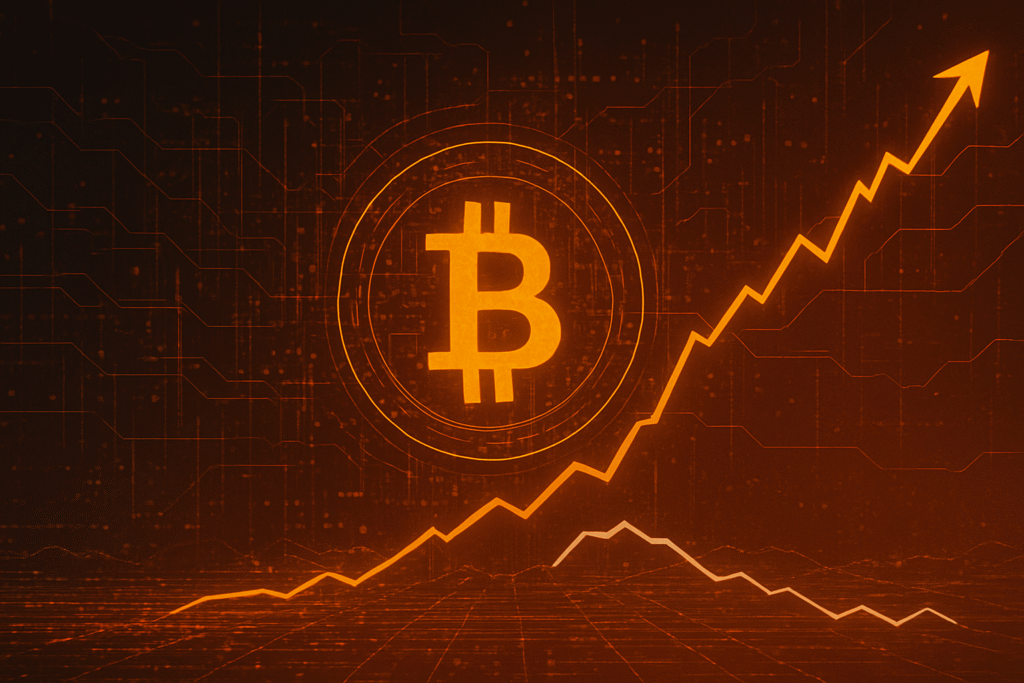
San Francisco, CA – October 16, 2025 – A groundbreaking revelation from CoinGecko's "2025 Q3 Crypto Industry Report" has sent ripples through the financial world, confirming a complete decoupling of Bitcoin (BTC) from the traditional stock market. For the third quarter of 2025, encompassing July, August, and September, Bitcoin demonstrated a zero-correlation coefficient with the S&P 500, marking a dramatic shift from its previous strong positive correlation of 0.9. This pivotal development, disclosed just weeks after the quarter's close, underscores Bitcoin's maturing role as an independent asset class and a potentially powerful portfolio diversifier.
The immediate implications of this report are profound, signaling a significant evolution in Bitcoin's market dynamics. For years, the crypto asset often mirrored the movements of major equity indices, leading many to question its true utility as a hedge against traditional market volatility. CoinGecko's findings challenge this narrative directly, suggesting that Bitcoin is increasingly forging its own path, driven by unique supply-demand mechanics and a growing perception as a digital store of value. This independence could fundamentally alter how institutional and retail investors perceive and allocate capital to Bitcoin, potentially unlocking new avenues for portfolio construction and risk management in an increasingly interconnected global economy. The report also highlighted a striking counter-trend: Bitcoin's statistical relationship with gold surged to a near-historical high of 0.9 on October 14, coinciding with gold's record price of $4179.48 per ounce, further solidifying its appeal as a safe-haven asset.
Market Impact and Price Action
The zero correlation between Bitcoin and the S&P 500 during Q3 2025 translated into a distinct and largely independent price action for the leading cryptocurrency. While specific real-time data for the entire quarter is still being fully compiled, the underlying trends observed leading into and through this period strongly suggest that Bitcoin's movements were predominantly driven by internal crypto market dynamics rather than traditional equity market sentiment. This continued a trend of declining correlation that saw Bitcoin (BTC) already establishing itself as a standalone asset, notably surging past the $100,000 mark after a previous zero-correlation observation around November 2024.
Throughout Q3 2025, Bitcoin demonstrated remarkable resilience. Analysts observed sustained upward price movements, even as the S&P 500 experienced periods of stagnation or minor downturns. This resilience was a hallmark of its decoupling, with BTC often rebounding independently of broader market sentiment. Key technical levels became increasingly significant, with Bitcoin navigating around the psychological $100,000 threshold, which solidified as a crucial base of support. Further analysis indicated major support at $108,000, while resistance levels were noted around $112,000 and $115,000, often acting as zones for profit-taking. A breakout above $126,418 was identified as a potential catalyst for a push towards $130,000.
Trading volume during these independent rallies remained robust, indicating strong market conviction and sustainable price action. High daily trading volumes, often exceeding $130 billion, underscored a liquid and efficient market, allowing for significant price discovery without undue volatility. This sustained liquidity, characterized by tight bid-ask spreads and deep order books across major exchanges, further reinforced Bitcoin's maturity as an independent asset. In contrast to past periods where Bitcoin acted as a "high-leverage tech stock" or an amplified version of the S&P 500, Q3 2025 showcased its capacity for self-driven momentum, echoing historical periods like the 2019 bull run where BTC surged independently of equities. The Chaikin Money Flow (CMF) consistently remained above zero, signaling healthy capital inflows, while the Stochastic RSI often indicated oversold conditions preceding strong rallies.
Community and Ecosystem Response
The release of CoinGecko's Q3 2025 report, definitively establishing Bitcoin's zero correlation with the S&P 500, ignited a wave of discussion and renewed optimism across the crypto community. On platforms like X (formerly Twitter) and Reddit, sentiment shifted from a previous skepticism about Bitcoin's true independence to a resounding validation of its "digital gold" narrative. CoinGecko's own announcement tweet on October 16, 2025, highlighting the findings, immediately became a focal point for conversations, with many celebrating Bitcoin's demonstrated momentum and its highest price levels since late 2021. This stark contrast to earlier discussions in March 2025, where Bitcoin was often seen mirroring the S&P 500, underscores the profound impact of this report.
Crypto influencers and thought leaders quickly weighed in, largely reinforcing the report's bullish implications. Experts from major financial institutions like BlackRock (NYSE: BLK), who as early as June 2025 had discussed Bitcoin's long-term correlation to the S&P 500 being near zero—similar to gold—found their predictions validated. They continued to advocate for a 1%-5% Bitcoin allocation in diversified portfolios. Market intelligence firms like IntoTheBlock echoed this sentiment, recalling that previous instances of low correlation, such as in November 2024, had preceded significant Bitcoin price rallies beyond $100,000. The report's finding of Bitcoin's near-historical high correlation of 0.9 with gold, coinciding with gold's record price, further solidified the "digital gold" narrative. This was bolstered by recent forecasts from JPMorgan (NYSE: JPM) and Lyn Alden in early October 2025, predicting Bitcoin to potentially hit $165K and surpass gold's market cap, respectively. Thought leaders like Joao Wedson, CEO and founder of Alphractal, also saw the report as validation of his earlier observations that Bitcoin exhibits more independent and significant price movements when negatively correlated with the S&P 500 during periods of low CBOE Volatility Index (VIX).
However, the report also highlighted a "structural divergence" within the broader crypto ecosystem. While Bitcoin forged its independent path, altcoins and other digital assets largely maintained their dependence on positive sentiment in the US stock market, with their correlation standing at 0.68. This suggests a potential dual-speed market, where Bitcoin acts as a primary hedge and store of value, while the performance of DeFi protocols, NFT projects, and Web3 applications built on alternative blockchains may still be influenced by "risk-on" sentiment in traditional finance. For instance, positive S&P 500 data has historically correlated with increased Ethereum (ETH) trading volumes, fostering opportunities in DeFi. Nevertheless, innovation within DeFi, NFTs, and Web3 continues unabated, driven by intrinsic technological merits and expanding use cases. Q2 2025 saw growing sophistication in DeFi infrastructure, advancements in real-world asset tokenization, and the maturation of Web3 into practical utility, with AI-powered DeFi protocols and tokenized government bonds as stable collateral emerging as significant trends.
What's Next for Crypto
The confirmed zero correlation between Bitcoin and the S&P 500 in Q3 2025 marks a pivotal moment, setting the stage for significant shifts in the crypto landscape both in the short and long term. As of October 16, 2025, the market is grappling with the profound implications of Bitcoin's newfound independence, which could redefine its role in global finance.
In the short term, Bitcoin's enhanced appeal as a genuine portfolio diversifier is paramount. Investors, particularly institutional players, are expected to increase allocations to BTC, seeking assets that move independently of traditional markets to mitigate risk and volatility. This decoupling also implies reduced sensitivity to conventional macroeconomic shocks, such as interest rate changes or inflation concerns, allowing Bitcoin's price movements to be increasingly driven by internal crypto market dynamics, technological advancements, and specific adoption trends. While Bitcoin's inherent volatility is likely to persist, these swings will be rooted in crypto-native catalysts rather than being a leveraged reflection of stock market fluctuations. Crucially, the "digital gold" narrative for Bitcoin gains significant traction, positioning it as a compelling hedge against global monetary instability.
Looking at the long-term implications, the sustained decoupling could accelerate Bitcoin's integration into mainstream institutional portfolios as a legitimate, separate asset class. This may lead to the development of more sophisticated, crypto-native valuation models that move beyond comparisons to equities, fostering a more nuanced understanding of digital asset value based on network effects, utility, and DeFi growth. While the report focuses on Bitcoin, a sustained decoupling for BTC could also pave the way for other major cryptocurrencies with strong fundamentals, such as Ethereum (ETH) and Solana (SOL), to exhibit lower correlations with traditional markets. Paradoxically, if Bitcoin becomes a widely accepted and deeply integrated uncorrelated asset, its extreme volatility might gradually temper over a very long horizon as more diverse and stable capital flows into the asset class, potentially solidifying its "risk-off" asset status.
Several potential catalysts and developments will be crucial in shaping this trajectory. Continued institutional adoption, driven by approvals of new spot ETFs (potentially for assets like Solana (SOL) and XRP), increased corporate treasury adoption, and broader integration into wealth management products, will be key. Regulatory clarity and stability globally will provide greater confidence for institutional participation. Technological advancements within Bitcoin's ecosystem, such as Layer 2 solutions, improving transaction speed and cost, will enhance its utility. Furthermore, the macroeconomic environment, including persistent global economic uncertainty, could further highlight Bitcoin's safe-haven properties. The widespread adoption of Real-World Asset (RWA) tokenization is predicted to drive significant growth, bridging traditional and digital finance, while the evolution of Decentralized Finance (DeFi), especially Bitcoin-based DeFi, will create stronger internal market dynamics.
Strategic considerations for projects and investors are now more critical than ever. Crypto projects must increasingly focus on their unique utility, technological innovation, and real-world applications, rather than simply riding correlated waves. Diversifying funding sources and proactive regulatory compliance are paramount. For investors, a critical re-evaluation of Bitcoin's role in portfolios is necessary, recognizing its potential as a true diversifier and potentially leading to larger allocations for those seeking to reduce overall portfolio volatility. Investors must understand that while diversification benefits exist, Bitcoin remains a highly volatile asset driven by crypto-specific factors. A long-term investment horizon, coupled with research into crypto-specific metrics, adoption rates, and technological developments, will be crucial.
Considering possible scenarios, the sustained decoupling of Bitcoin (High-Medium Likelihood) is the most optimistic, supported by its unique attributes and growing institutional interest. This scenario would cement Bitcoin's "digital gold" narrative. A partial recoupling or fluctuating correlation (Medium Likelihood) is also plausible, where Bitcoin's correlation might still return during periods of extreme global market stress, as even uncorrelated assets can become linked in severe market events. The temporary decoupling scenario (Low Likelihood), suggesting Q3 2025 was an anomaly, appears less likely given the consistent narrative and increasing institutional conviction around Bitcoin's distinct properties.
Bottom Line
CoinGecko's "2025 Q3 Crypto Industry Report," released on October 16, 2025, delivers a clear and resounding message: Bitcoin (BTC) has achieved a significant milestone by exhibiting zero correlation with the S&P 500 during the third quarter. This pivotal finding, a stark contrast to previous strong correlations, fundamentally reshapes Bitcoin's narrative and its role in investment portfolios. Key takeaways for investors and enthusiasts include Bitcoin's undeniable evolving independence from traditional stock markets, its strengthened "digital gold" status evidenced by a near-historical high correlation of 0.9 with gold (which itself hit a new record of $4179.48 per ounce), and a notable divergence in altcoin behavior, with other digital assets maintaining a moderate correlation of 0.68 with the S&P 500. The broader crypto market also showed robust performance in Q3, with total market capitalization climbing to $4.0 trillion, marking its highest level since late 2021, and significant resurgences in DeFi and stablecoin sectors. Bitcoin's annual volatility also saw a healthy decrease from 42.1% to 29.2%.
The long-term significance of this decoupling for crypto adoption is profound. Bitcoin is increasingly shedding its image as a highly speculative, high-beta tech asset and is emerging as a distinct, resilient financial instrument. This independence from the S&P 500, coupled with its reinforced store-of-value proposition, makes a compelling case for its inclusion in diverse investment portfolios as a true uncorrelated asset. This shift is expected to accelerate institutional adoption, building greater credibility and trust, paving the way for broader mainstream acceptance. The substantial institutional inflows into US spot Bitcoin ETFs since their 2024 approval, accumulating over 1.29 million BTC (approximately 6% of total supply), already underscore this growing confidence. The segmentation of the crypto market, with Bitcoin showing independence while altcoins maintain some traditional market ties, necessitates more nuanced investment strategies.
In final thoughts on crypto adoption, the Q3 2025 CoinGecko report signals a transformative period for crypto adoption. Bitcoin's maturation, characterized by declining volatility and continued institutional embrace, points towards a future where it is widely recognized and adopted as a legitimate and integral component of the global financial landscape. Its ability to forge an independent path from traditional equities strengthens its position as a hedge and diversifier, a critical attribute in an increasingly uncertain global economy. This development not only enhances Bitcoin's appeal but also sets a precedent for the entire digital asset ecosystem to mature beyond being merely a reflection of tech stocks.
As of October 16, 2025, important dates, events, or metrics to monitor include: continuous tracking of Bitcoin's correlation coefficients with both the S&P 500 and gold to confirm persistence of these trends; sustained institutional investment flows, particularly into Bitcoin Spot ETFs and corporate treasuries; the growth in stablecoin market capitalization and DeFi Total Value Locked (TVL) as indicators of ecosystem health; ongoing global regulatory updates; broader macroeconomic indicators influencing capital flows; and observing whether altcoins begin to follow Bitcoin's decoupling trend. These metrics will collectively paint a clearer picture of Bitcoin's evolving role and the future trajectory of crypto adoption.
This article is for informational purposes only and does not constitute financial or investment advice. Cryptocurrency investments carry significant risk.





